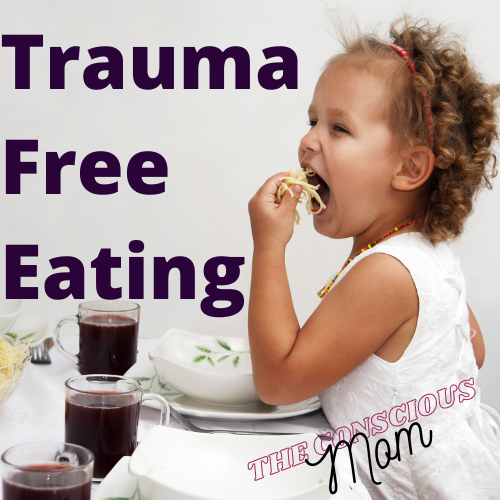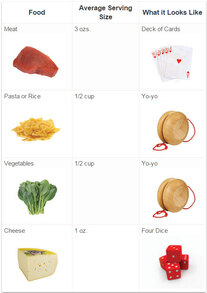|
2/2/2021 0 Comments Child Friendly Portion SizesAre you feeding your child too little, too much, or just enough?
0 Comments
2/1/2021 0 Comments Keeping Portions Under ControlThese days, lots of us eat too much and don't realize it because we've become so used to seeing (and eating!) large portions. The Problems of Eating Too Much People who often overeat are likely to become overweight. They also risk getting a number of medical problems, including high blood pressure, high cholesterol, type 2 diabetes, bone and joint problems, breathing and sleeping problems, and even depression. Adults who are overweight or obese are at greater risk for heart disease, heart failure, and stroke. It's easy to understand why the food industry tends to serve way more food than is necessary: Customers love to feel like they're getting the best value for their money! But the value meal is no deal when it triples our calories and sets the stage for health problems. The Truth About Serving Sizes One reason that people eat too much at meals is that they tend to eat what's on their plate. As portions have increased, so have the calories we eat. So it's helpful to understand the difference between serving sizes and recommended amounts of different foods. Serving sizes. The serving size on a food label is not telling you the amount you should eat. The serving size is a guide to help you see how many calories and nutrients — as well as how much fat, sugar, and salt — are in that quantity of that food. Sometimes the serving size on the food label will be a lot less than you are used to eating or serving. In some cases, it's perfectly OK (and even a good idea) to eat and serve more than the serving size listed. For example, if you're cooking frozen vegetables and see the serving size is 1 cup, it's no problem to eat more because most vegetables are low in calories and fat, yet high in nutrition. But when it comes to foods that are high in calories, sugar, or fat, the serving size is a useful guide to alert you that you may be getting more than is healthy. Let's say you buy a 3-ounce bag of cookies and you eat the whole bag. If the label shows the serving size is 1 ounce, not only did you have 3 servings, you also had 3 times the listed calories as well as 3 times the sugar. Recommended amounts. Serving sizes tell you how much nutrition you're getting from a food but they don't tell you which foods you need to stay healthy — or how much of those foods to eat. That's where the U.S. Department of Agriculture's MyPlate comes in. MyPlate is based on the Dietary Guidelines for Americans. It can help you get the right mix and amount of food for you and your family. What to Look for A great way to think about healthy portion sizes is to use the concept of the "divided plate." Think of a plate divided into four equal sections:
The foods in each section should not overlap or be piled high. Dividing the plate this way not only will help you keep portions under control, but will help you serve more balanced meals to your family. Portion-Control Tips Parents need to take control of our own portion sizes and help kids learn to do the same. Here are some tips:
Getting Kids Involved Get kids actively involved in figuring out how much to eat. A serving of rice is about the same size as an ice cream scoop, so let your child use the scoop to serve "rice cream" to the family. A piece of meat should be about the size of a deck of cards, so see how that chicken breast measures up. And why not break out the kitchen scale while you're at it? Weighing or measuring food may not be your idea of fun, but it probably is to your kids — plus it's a great way to reinforce math concepts. One easy way to size up portions if you don't have any measurements is to use your hand as a guide. Kids have smaller hands than adults, so it serves as a reminder that kids should eat smaller portions:
And don't forget the good news about portions: they work both ways. You may want to cut back on spaghetti portions, but you can dish out more than one serving of carrots or green beans. This can help make the "five a day" fruit and vegetable goal more doable. Remember the role you play in showing kids how to size up portions. If you eat two heaping helpings of food each night, that's what your kids will learn too. As kids grow, their appetites will vary depending on a number of things. They tend to be more hungry during growth spurts or sports seasons when they're more active, and less hungry during downtimes. As their appetites change, keep serving right-sized portions and encourage them to slow down to enjoy their food. Then check in on whether they're full before they go for seconds. The above information was published to Kidshealth.Org by Nemours Children's Health System and reviewed by Mary L. Gavin, MD June 2018.
1/30/2021 0 Comments While pressuring a child to eat is usually done with the best of intentions, it can have unintended consequences.Parents are often worried when their child eats very little, does not eat healthy foods like fruits and vegetables, or refuses a meal completely. For some, this worry can be significant, particularly if the child is not gaining weight well, or is losing weight. For others, uneaten meals can be a source of frustration. Often parents find themselves using pressure, force or coercion to try and get their child to finish their meal. This can take many forms:
Using all of these behaviours has the opposite effect to what was intended. While a child may eat a little more when being coerced, the act of being pressured into eating can lead to the development of negative associations with the food, and ultimately dislike and avoidance. It can also stop children from recognising and responding appropriately to internal signals of hunger and fullness, which can make them more likely to overeat in later life. Why is it bad to pressure or strongly encourage a child to eat? Parents' use of pressure to eat often stems from worry and anxiety regarding how or what a child is eating. Parents can become concerned about their child's health and wellbeing (and ultimate survival) if they feel that their child is not eating enough to sustain healthy development. If a child is underweight, parents are more likely to want to encourage eating and may end up using pressure without realising that they may have the opposite effect to that desired. Parental pressure to eat can also stem from a desire to avoid wasting food that has been prepared, and the belief that children should 'clean their plates'. However, sometimes the portion sizes that we serve to children are unrealistically large, meaning that it is unrealistic to expect the child to finish the meal and every meal will appear 'unfinished'. In this case, it is not the child eating too little, but the portion size being too large. Pressure to eat has been linked with a number of negative consequences. These are:
Although hunger and fullness are internal feelings, research has shown that they can be overridden by a number of factors. Pressure to eat is one way by which children might be urged to eat more than their body requires. Over time, feelings of fullness lose their significance, as they no longer signal that the meal should stop. Rather, children learn to continue eating, even after they start to feel full, stopping only when their plate is empty, or when their parent says that it is okay to stop. This means that children listen less to their body and so food intake becomes dictated by factors other than what the body requires. Research has also shown that children eat on average 30% more when offered a larger portion of food. Offering children portion sizes that are too large and pressuring children to eat more than they desire are important factors in the development of overeating and overweight. What should I do instead?Except in very rare cases, children are extremely good at knowing when they are hungry and when they are full. Therefore, it is important to trust them and believe that they will eat if they are hungry. By doing this, you should not feel a need to pressure your child to eat. This is something that they will do willingly if their body requires food. Similarly, children's natural tendencies to reject new or bitter foods should not be met with pressure. Rather, keep offering foods and accept refusal, acknowledging that this is a normal developmental phase and that what you do is important in determining whether this is a positive or negative experience for your child. Things to try
(Information about suitable portion sizes for toddlers can be found here. The above information is available at https://www.childfeedingguide.co.uk/
The Child Feeding Guide is underpinned by internationally respected expertise from Loughborough and Aston Universities in the UK. Our research looks at various aspects of children's eating behaviour and parenting at mealtimes. 1/28/2021 0 Comments How Much and How Often To FeedFrom 6 to 12 months old, breast milk and/or infant formula is still the main source of nutrition for your child, but solid foods will gradually begin to make up a bigger part of his or her diet. As you begin to give food to your child, it can be hard to know how much to give him or her to eat. Children’s bellies are small and cannot hold a lot of food. Here are things to keep in mind:
The above information was published to Kidshealth.Org by Nemours Children's Health System.
"My 2-year-old used to be a pretty good eater. But now she's going through a phase where she won't even try the vegetables I serve. How can I get more veggies into her mouth and off the floor? – Mila" As most parents know, there are two things you can't force a child to do: eat and sleep. This is especially true of toddlers, who often assert their independence through eating — or not eating — the foods you put on their plates. Many toddlers turn their noses up at vegetables. But don't give up — with time and patience, even the pickiest eaters can find several veggies they like (and a few they even love!). Here are some tips that might help:
One thing to keep in mind when serving fresh fruit and veggies: Raw vegetables and hard fruits can be a choking hazard for young children. Be sure to cook them well, and thinly slice or cut them into small enough pieces so that they're not a choking risk. The above information was published to Kidshealth.Org by Nemours Children's Health System and reviewed by Mary L. Gavin, MD July 2018.
|
Various SOurcesBest practices in child nutrition. ArchivesCategories |




 RSS Feed
RSS Feed